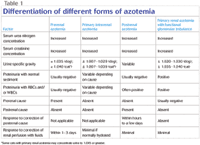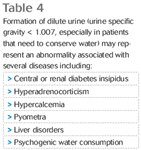When urine specific gravity values go awry in veterinary practice
Several diagnostic factors must come into play when a veterinarian gets an abnormal result on this common test that investigates kidney function. (Part three of a four-part series.)
In a previous issue of dvm360 ("Urine specific gravity measurement and interpretation in veterinary medicine," May 2013), we discussed the variables influencing normal specific gravity values. Here, we continue this review by discussing the pathophysiology of abnormal values.
Impaired urine concentration
The interpretation of urine specific gravity values of randomly obtained samples depends on knowledge of the patient's hydration status and diet history, the plasma or serum concentration of urea nitrogen or creatinine, and knowledge of drugs or fluids that have been administered to the patient. Urine volume and water consumption may also be helpful. In some instances, interpretation may require serially performed evaluation of urine specific gravity on multiple samples. In others, evaluation of urine and plasma osmolality is needed.

GETTY IMAGES/PAUL MASON
If sufficient clinical evidence is present to warrant examination of the patient's renal function by determining the serum concentration of creatinine or blood urea nitrogen, the urine specific gravity (or osmolality) should be evaluated at the same time. Why? Because an adequately concentrated urine sample associated with an abnormal elevation in the serum creatinine or urea nitrogen concentration suggests the probability of prerenal azotemia, whereas intrarenal azotemia is probable in patients with elevated serum urea nitrogen and creatinine concentrations and less concentrated urine (Tables 1, 2 and 3).

Table 1: Differentiation of different forms of azotemia
Varying degrees of impaired ability to concentrate or dilute glomerular filtrate are a consistent finding in all forms of primary renal failure but not all forms of renal disease. Because the kidneys have substantial functional reserve capacity, impairment of their ability to concentrate or dilute urine may not be detected until at least two-thirds (dogs) or more (cats) of the total population of nephrons has been damaged.

Table 2: Urine specific gravity values
Complete inability of the nephrons to modify glomerular filtrate typically results in formation of urine with a specific gravity that is similar to that of glomerular filtrate (1.008 to 1.012). This phenomenon has commonly been called fixation of specific gravity. Once the ability to concentrate or dilute urine has been permanently destroyed, repeated evaluation of urine specific gravity will not help in the evaluation of progressive deterioration of renal function. Therefore, serial evaluation of urine specific gravity is of greatest aid in detecting functional changes earlier during the course of progressive primary renal failure or in monitoring functional recovery associated with reversible renal diseases.

Table 3: Osmolality and urine specific gravity values for dog, cat and human urine
Total loss of the ability to concentrate and dilute urine (specific gravity = 1.008 to 1.012) often does not occur as a sudden event but may develop gradually. For this reason, urine specific gravity values between about 1.007 to 1.029 in dogs and 1.007 to 1.039 in cats associated with azotemia are highly suggestive of primary renal failure, although, on occasion, hypoadrenocorticism may induce similar findings (Tables 1, 2 and 3). Likewise, urine specific gravity values between about 1.007 to 1.029 in dogs and 1.007 to 1.039 in cats that are clinically dehydrated but not azotemic are highly suggestive of primary renal failure or other disorders that impair urine concentrating capacity (Table 4).

Table 4: Formation of dilute urine (urine specific gravity
If nonazotemic patients have impaired ability to concentrate urine, investigate causes of pathologic polyuria. If you determine the urine specific gravity or osmolality, it may allow you to determine whether a polyuric disorder characterized by water (1.001 ± 1,006) or solute (±1.008 or greater) diuresis is probable.
Water deprivation testing
If a nondehydrated, nonazotemic patient suspected of having pathologic polyuria does not have a urine specific gravity that indicates that the kidneys can definitely concentrate urine, further "provocative" tests are required before you can conclude anything about the kidneys' capacity to concentrate urine. By depriving a nonazotemic, nondehydrated patient of water consumption for an appropriate period of time, antidiuretic hormone will normally be released from the posterior pituitary gland as a compensatory response to hydropenia. Antidiuretic hormone enhances fluid reabsorption from the distal tubules and collecting ducts by increasing tubular epithelial cell permeability to water.
Clinical experience has revealed that the results of water deprivation tests are often difficult to reproduce. Boundary values have been established, above which renal function is assumed to be adequate and below which it is assumed to be impaired. A zone of doubt exists in between.
Uncontrolled clinical observations indicate that dogs with "adequate" renal function will excrete urine with a high specific gravity (1.030), high osmolality and relatively small volume (physiologic oliguria). Studies of dogs with completely normal renal function were interpreted to indicate that 95 percent of normal dogs subjected to water deprivation sufficient to produce a slight degree of dehydration should have a urine specific gravity of at least 1.048, a urine osmolality of at least 1,787 mOsm/kg and a U/Posm ratio of at least 5.7 to 1.1 If such values are not obtained, nephron dysfunction may exist. The degree of dysfunction, however, may not be severe enough to be associated with clinical signs. Evaluate patients unable to concentrate urine after appropriately conducted water deprivation tests for diseases that cause medullary solute depletion, central diabetes insipidus or renal diabetes insipidus.
Mechanisms of polyuria in primary renal failure
When urine specific gravity reflects an impaired ability to concentrate (or dilute) urine, it is more an index of nephron function than of distal tubular and collecting duct function. Why? In addition to generalized tubular lesions that impair the function of the countercurrent system, this abnormality may be intensified as a result of factors not specifically related to tubular damage. These factors include:
> Compensatory increase in glomerular filtration (so-called hyperfiltration) that occurs as a result of a decrease in the quantity of functional nephrons. Increased production of glomerular filtrate floods the distal tubules and collecting ducts with solute and water. It is associated with decreased fractional tubular reabsorption of sodium and phosphorus by viable nephrons.
> Decrease in the number of functioning nephrons. The latter is associated with an impaired ability of the countercurrent mechanism to maintain the high osmotic gradient normally present in renal medulla.
> Osmotic diuresis in the remaining functional nephrons as a result of increased filtration of solutes (azotemia, hyperphosphatemia, etc.) in them secondary to reduced glomerular filtration (Tables 1, 2, 3). This accentuates the degree of obligatory polyuria.
The next article in this series will discuss urine specific gravity values and localization of azotemia.
Dr. Carl A. Osborne is the director of the Minnesota Urolith Center and a professor at the College of Veterinary Medicine at the University of Minnesota. Dr. Eugene Nwaokorie is pursuing a PhD at the University of Minnesota.
REFERENCE
1. Hardy RM, Osborne CA. Water deprivation test in the dog: maximal normal values. J Am Vet Med Assoc 1979;174(5):479-483.
Inhaled albuterol offers more accessible treatment option for elevated potassium levels in cats
April 2nd 2025A recent study explored the effect of inhaled albuterol sulfate in reducing blood potassium levels in felines, which offers a potential treatment option for urinary obstruction-related hyperkalemia
Read More
Podcast CE: A Surgeon’s Perspective on Current Trends for the Management of Osteoarthritis, Part 1
May 17th 2024David L. Dycus, DVM, MS, CCRP, DACVS joins Adam Christman, DVM, MBA, to discuss a proactive approach to the diagnosis of osteoarthritis and the best tools for general practice.
Listen